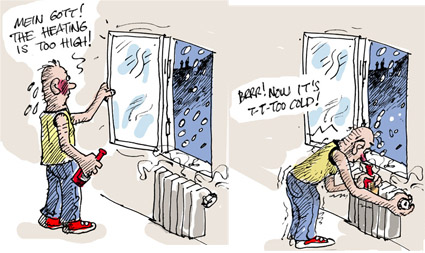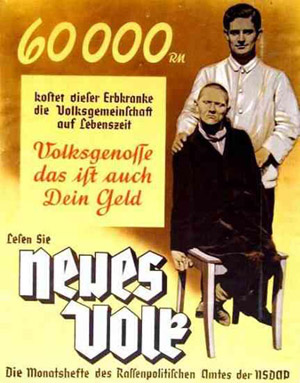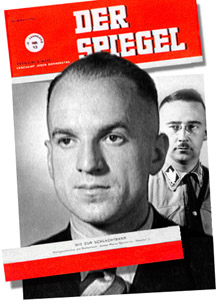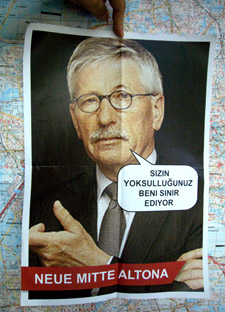Our Money
7. 9. 2012 // Federico Geller // Kategorie Randnotizen 2012
“60,000 Reichsmarks is what this hereditary defective costs to the community during his lifetime. Comrade, that is your money too. Read ‘New People’, the monthly magazine of the Bureau for Race Politics of the NSDAP.”
In 1938 the mentally ill were in the eye of the German State budget storm. Posters, films and other propaganda elements looked for support for the Aktion T4, the euthanasia Program which killed, between 1939 and 1945, around 200,000 people with mental or phisical disabilities. According to their financial logic, that could have meant savings for 12,000,000,000 RM after the war, which may explain at least a fraction of the german miracle.
Today, an equivalent advertising would show an unemployed or a turkish immigrant or a greek public servant (and a member of the Troika instead a doctor). Those people are spending all OUR money day by day: every milisecond OUR money is being used by lazy bastards. Because it’s my money too, as german corporations have made very good business in Argentina.
Just after the war, the Allies concentrated in Germany close to 250.000 jews from Eastern Europe in camps for “Displaced Persons” or DPs . Most of them emigrated to Israel and other countries, but 10% remained and became the basis of the new german jewish community. The food supply of the DP camps was a source of never-ending complaints. From the point of view of the average german citizen, the aid given to Holocaust survivors with OUR money was excessive. In 1950 the former SS officers Horst Mahnke and George Wolff, recycled as journalists in Der Spiegel, published together the saga Am Caffehandel betheiligt, where they accussed the DPs of smuggling coffee. They calculated that the jewish Kaffeschmuggel costed to the State one billion Deutsche Marks.
The banker and writer Thilo Sarrazin, who considers that Germans still support the Euro because they haven´t solved their Holocaust guilt, actualises this mental operator against poor and foreign: marginals steal our common treasure and then our common future is in danger. We have to act: the State must do something in our name. The vector of this blind identification with the money owners goes upwards. And the arrow that points downstairs is the void of exclusion: the energy that build the cultural system of human diversity devalorisation and the police engineering of borders and deportation. This verticality seems to occupy the potencial social and mental space of the interclass struggle but it also neutralises horizontal confrontations up & down: it provides a defensive cohesion in those who are integrated and increases the dispersion of the marginal ones.

“First, Hartz IV receivers are more at home, second, they like it warm, and thirdly, many regulate the temperature with the window.” (Thilo Sarrazin talking about people who receive unemployment money, 2009)
This poster was part of an action made by neighbours of Hamburg in April 2012 against the speculative urbanistic adventure of Neue Mitte Altona. Sarrazin, the confortable Don Quijote of gentrification says in turkish: “Your poverty makes me vomit”. The sentence, that in german is “Eure Armut kotzt mich an”, was used in stickers during the ´90s refering to the yuppie scene.
In the next post we will remember the visit of Thilo Sarrazin in 2011 to the neighbourhood of Kreuzberg, Berlin, and see some options artists and image producers have against the process of gentrification.





